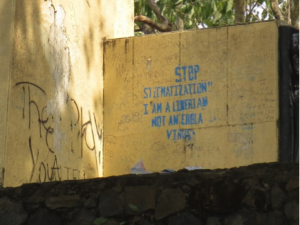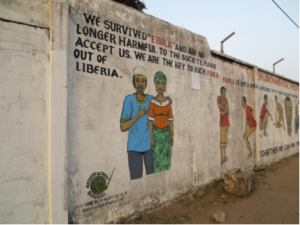
by Karine Dube
Ebola infected over 28,000 people during the 2013 – 2016 outbreak in West Africa, including between 500 and 1,000 health care workers who died. There are over 10,000 Ebola virus disease survivors mainly in Guinea, Sierra Leone and Liberia. As Nancy Sullivan stated during the CROI 2016 special session on Ebola, “we now have the opportunity to dig a little bit of hope in what was an enormous tragedy.” Ebola-related clinical research is now possible and the number of survivor cases is sufficient to start deriving meaningful data.
The Ebola virus belongs to the family of filoviruses and is composed of an enveloped, stranded RNA virus. Ebola is transmitted by contact with bodily fluids, through social networks, nosocomial infections and unsafe burial practices. There are 5 species of Ebola of varying virulence and disease progression, and clinical progression follows 4 phases, including early febrile illness, gastro-intestinal complications, shock or recovery and late complications. The case fatality is between 30 – 90% depending on the availability of treatment.
What has Ebola taught us about “treatment” and “cure” research? A lot still needs to be discovered about the Ebola virus, but the recent outbreak lead to substantial new knowledge about how to treat the Ebola virus. Patients with Ebola were found to have high level of creatinine kinase (CK) and those with fatal outcomes had higher creatinine and bilirubin levels and more frequent renal failures that those who survived. The World Health Organization (WHO)’s latest clinical guidelines can be found here: http://www.who.int/csr/resources/publications/ebola/en/. There are no license treatment proven to neutralize Ebola; however, there are drug candidates in various phases of clinical development and supportive care can take the form of rehydration and symptomatic treatment in order to improve changes of survival. Two potential Ebola vaccine candidates are being evaluated, including VSVΔZEBOV vaccine and ChAd3-EBO-Z.

The Ebola special session at CROI 2016 highlighted some of the findings from the survivor cohorts to date:
- Eugene Richardson from Stanford University reported that Ebola seropositive patients can be asymptomatic. Of the participants surveyed in the Kono District in Sierra Leone, 12/207 (5.8%) were positive for Ebola IgG, but were asymptomatic. The data point toward a clinical spectrum of EVD that includes asymptomatic infection. One question that remains is whether the notion of survivorship should be extended to all patients who tested positive for Ebola antibody – including those who were asymptomatic.
- Jean-François Étard from the French Institut de Recherche pour le Développement reported on the sequelae of EVD in surviving patients in Guinea. Similar to HIV, EVD may be associated with long-term medical complications (such as ophthalmologic problems and muscle pain) as well as psychosocial consequences. Dr. Étard’s study team confirmed the viral RNA persistence of Ebola in semen, thus the need to maintain surveillance. No positive breastmilk result was yet reported in this study.
- Mosoka Fallah reported on the results of the PREVAIL III study in Monrovia, Liberia. This study found that 38% of male tested had viral Ebola RNA detected in the semen at least once and shedding of the virus was often intermittent. The study will continue examining the persistence of EBV in bodily fluids, including spinal fluid, vaginal secretions and breastmilk. At this time, the significance of the EBV PCR test is unclear – including whether this represents viable virus (e.g. true EBV “reservoir” that we need to worry about) or simply scraps of nucleic acid. Ongoing discussions are underway with the NIH and the CDC to determine the significance of the PCR Ebola test.
- Daouda Sissiko from INSERM, France discussed the dynamics of Ebola clearance in semen in Guinea. Of the patients surveyed, 19/29 (73%) had positive RNA in semen at first measurement, with a trend towards viral decline over time. This study showed the long persistence of the Ebola RNA in the semen and the potential risk for sexual transmission.
Implications for “Cure” Research:
As of now, Ebola survivors may be considered “functionally cured” or “convalescent cases”. Survivors are not contagious (e.g. person-to-person skin contact), although more work will need to be done to determine the infectivity of persistent virus in bodily fluids. Results suggest that counseling and safe sexual practices should be emphasized, together with monitoring of Ebola RNA in semen.
The Ebola outbreak showed the difficulty of conducting “cure” research in the midst of an outbreak, especially in the absence of control (fatal cases vs. survivors). More work will need to be to elucidate the mechanism of EBV persistence, although it is known that Ebola does not integrate itself into the host’s DNA (unlike HIV). Ongoing clinical studies in West Africa will attempt to determine the long-term sequelae of Ebola virus disease. Additionally, it will be important to assess the psychosocial consequences of Ebola, including stigma, and to cooperate with the local public health authorities to ensure that Ebola survivors have access to adequate care. Community engagement will be critical to successfully completing studies with Ebola survivors and to controlling outbreaks in the future.

